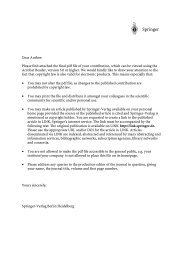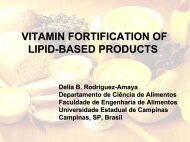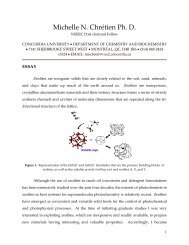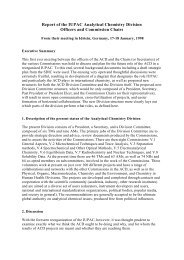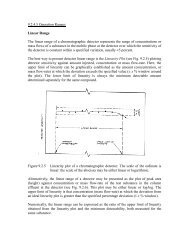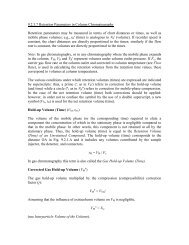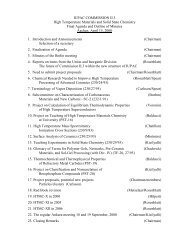Thai Zingiberaceae : Species Diversity And Their Uses
Thai Zingiberaceae : Species Diversity And Their Uses
Thai Zingiberaceae : Species Diversity And Their Uses
Create successful ePaper yourself
Turn your PDF publications into a flip-book with our unique Google optimized e-Paper software.
URL: http://www.iupac.org/symposia/proceedings/phuket97/sirirugsa.html<br />
© 1999 IUPAC<br />
<strong>Thai</strong> <strong>Zingiberaceae</strong> : <strong>Species</strong> <strong>Diversity</strong> <strong>And</strong><br />
<strong>Their</strong> <strong>Uses</strong><br />
Puangpen Sirirugsa<br />
Department of Biology, Faculty of Science, Prince of Songkla University, Hat Yai, <strong>Thai</strong>land<br />
Abstract: <strong>Zingiberaceae</strong> is one of the largest families of the plant<br />
kingdom. It is important natural resources that provide many useful<br />
products for food, spices, medicines, dyes, perfume and aesthetics to<br />
man. Zingiber officinale, for example, has been used for many years as<br />
spices and in traditional forms of medicine to treat a variety of diseases.<br />
Recently, scientific study has sought to reveal the bioactive compounds<br />
of the rhizome. It has been found to be effective in the treatment of<br />
thrombosis, sea sickness, migraine and rheumatism.<br />
GENERAL CHARACTERISTICS OF THE FAMILY ZINGIBERACEAE<br />
Perennial rhizomatous herbs. Leaves simple, distichous. Inflorescence terminal on the leafy<br />
shoot or on the lateral shoot. Flower delicate, ephemeral and highly modified. All parts of the<br />
plant aromatic. Fruit a capsule.<br />
HABITATS<br />
<strong>Species</strong> of the <strong>Zingiberaceae</strong> are the ground plants of the tropical forests. They mostly grow<br />
in damp and humid shady places. They are also found infrequently in secondary forest. Some<br />
species can fully expose to the sun, and grow on high elevation.<br />
DISTRIBUTION<br />
<strong>Zingiberaceae</strong> are distributed mostly in tropical and subtropical areas. The center of<br />
distribution is in SE Asia. The greatest concentration of genera and species is in the Malesian<br />
region (Indonesia, Malaysia, Singapore, Brunei, the Philippines and Papua New Guinea)<br />
*Invited lecture presented at the International Conference on Biodiversity and Bioresources: Conservation<br />
and Utilization, 23–27 November 1997, Phuket, <strong>Thai</strong>land. Other presentations are published in Pure Appl.<br />
Chem., Vol. 70, No. 11, 1998.
ZINGIBERACEAE IN ASIAN COUNTRIES<br />
Area Genera <strong>Species</strong><br />
World (total) 52 1,500<br />
China 21 200<br />
India 18 120<br />
Indochina 14 120<br />
Malesia 25 650<br />
Nepal 11 35<br />
The Philippines 15 103<br />
<strong>Thai</strong>land 20 200<br />
CLASSIFICATION<br />
<strong>Zingiberaceae</strong> is divided into 4 tribes<br />
- HEDYCHIEAE<br />
- ZINGIBEREAE<br />
- ALPINEAE<br />
- GLOBBEAE<br />
ZINGIERACEAE OF THAILAND<br />
Total no. No.of sp. in<br />
of sp. <strong>Thai</strong>land<br />
HEDYCHIEAE Boesenbergia 45 14<br />
Caulokaempferia 10 5<br />
Cautleya 5 1<br />
Curcuma 80 50<br />
Curcumorpha 1 1<br />
Haniffia 2 2<br />
Hedychium 60 20<br />
Kaempferia 50 15<br />
Scaphochlamys 25 2<br />
Stahlianthus 7 1<br />
ZINGIBEREAE Zingiber 90 35<br />
ALPINIEAE Alpinia 250 20<br />
Amomum 125 20<br />
Elettariopsis 30 3<br />
Etlingera 60 4-5<br />
Geostachys 16 3<br />
Hornstedtia 35 1-2<br />
Pomereschia 2 1<br />
GLOBBEAE Gagnepainia 3 3<br />
Globba 70 40<br />
© 1999 IUPAC 2
THE STUDY OF ZINGIBERACEAE IN THAILAND<br />
The taxonomic study of the family <strong>Zingiberaceae</strong> was first studied by Kai Larsen (1980) who<br />
proposed the key to genera of <strong>Thai</strong> <strong>Zingiberaceae</strong>. However, the study of <strong>Zingiberaceae</strong> has<br />
been going slowly due to the lack of adequate specimens. Old collections are useless as they<br />
consist of either sterile or spoiled material. The delicate flowers are often damaged during the<br />
drying process. The best way to collect specimens of this family is to preserve the flowers in<br />
70% alcohol.<br />
The aim of the study of <strong>Thai</strong> <strong>Zingiberaceae</strong> is to complete the taxonomic revision of<br />
the family and to be published in the Flora of <strong>Thai</strong>land. So far, five genera have been revised.<br />
They are: Caulokaempferia (Larsen, 1964) Boesenbergia (Sirirugsa, 1992) Kaempferia<br />
(Sirirugsa, 1992), Scaphochlamys (Sirirugsa & Larsen, 1991) and Hedychium (Sirirugsa,<br />
1995). The genus Curcuma has been currently studied by the author. More than 50 species of<br />
this genus have been found to occur in <strong>Thai</strong>land, with only 26 of them being formally<br />
identified. The genus Zingiber has been treated by Theilade & Maersle - Moller (1991). In a<br />
preliminary study, 33 species were recognized.<br />
However, many more genera of <strong>Zingiberaceae</strong> still remain to be studied before<br />
finishing the entire family for the Flora of <strong>Thai</strong>land. The field collections as well as the<br />
research collaboration of this family are highly needed.<br />
REPRESENTATIVES OF THAI SPECIES<br />
1. Curcuma longa L.<br />
Distinguished characters.- Rhizome branched, bright yellow. Flower bracts greenish yellow.<br />
Coma bracts pale yellow.<br />
<strong>Thai</strong>land.- Cultivated throughout the country.<br />
Distribution.- Cultivated widely in Asia.<br />
<strong>Uses</strong>.- Turmeric powder is used as cosmetics in lndia. It is also sacred in many social and<br />
religious rites. It is used as a coloring matter in pharmacy, confectionery and food<br />
industries. Fresh or dried rhizome is used as spice. The rhizome is stomachic, stimulant<br />
and carminative. It is used as a remedy for diarrhea, rheumatism and is also used to<br />
relieve cough and tuberculosis.<br />
2. Curcuma parviflora Wall.<br />
Distinguished characters.- Rhizome small, white. Flower bracts green. Coma bracts and<br />
staminodes white. Labellum purple.<br />
<strong>Thai</strong>land .- Common in the mixed forest of North and Northeast, rare in the Peninsula<br />
Distribution.- Myanmar, India, Indochina, Indonesia, Malaysia.<br />
<strong>Uses</strong>.- The inflorescence is eaten as vegetable. The pulp of the rhizome is scraped and applied<br />
to cuts.<br />
3. Curcuma xanthorhiza Roxb.<br />
Distinguished characters.- Rhizome large, ovoid, dark orangish-yellow.<br />
<strong>Thai</strong>land.- NORTHREN: Chiang Mai, SOUTHEASTERN: Chantaburi,Trat; PENINSULA:<br />
Phang-nga.<br />
Distribution.- India, Indonesia, Malaysia.<br />
© 1999 IUPAC 3
<strong>Uses</strong>.- it is used extensively in traditional medicine. For examples : Remedies for bloody<br />
diarrhea, dysentery, fevers, hemorrhoids, stomach disorder, infected wounds and skin<br />
eruptions.<br />
4. Curcuma zedoaria Rosc.<br />
Distinguished characters.- The rhizome pale yellow or white inside. The coma bracts dark red<br />
to purple.<br />
<strong>Thai</strong>land.- NORTHERN: Chiang Rai, Chiang Mai; EASTERN: Nakhon Ratchasima,<br />
CENTRAL: Saraburi; SOUTHEASTERN: Trat.<br />
Distribution.- India (Himalaya), Southeast Asia.<br />
<strong>Uses</strong>.- Young rhizome is eaten as vegetable soup. Rhizomes are used in relief of stomachache<br />
and as a carminative. It is also used in perfumery. Leaves are used for flavoring fish and<br />
other food.<br />
Many species of the genus Curcuma are the economic plants for the aesthetics of their<br />
flowers. For examples:<br />
5. Curcuma alismatifolia Gagnep.<br />
Distinguished characters.- Peduncle long, slender and stiff. The coma bracts pink, large and<br />
erect. The trade name for this species is known as “Siam Tulip”. Its bulbs are exported to<br />
Japan and Europe.<br />
<strong>Thai</strong>land.- SOUTHWESTERN: Utai-Thani.<br />
Distribution.- Cambodia.<br />
6. Curcuma aurantiaca van Zijp<br />
Distinguished characters.- The flower bracts greenish-orange. The coma bracts bright pink.<br />
<strong>Thai</strong>land.- PENINSULA: Ranong.<br />
Distribution.- Ceylon, Indonesia, Malaysia.<br />
7. Curcuma petiolata Wall.<br />
Distinguished characters.- The inflorescence large, may be the largest of the genus. The<br />
flower bracts greenish, the coma bracts pink.<br />
<strong>Thai</strong>land.- NORTHERN: Uttaradit.<br />
Distribution.- Myanmar.<br />
8. Curcuma roscoeana Wall.<br />
Distinguished characters.- The flower bracts bright orange. No coma bracts. It has been well<br />
known as ornamental plant and has become an important export of <strong>Thai</strong>land.<br />
<strong>Thai</strong>land.- NORTHERN: Mae Hong Son, Phitsanulok; SOUTHWESTERN: Kanchanaburi.<br />
Distribution.- Myanmar and commonly cultivated.<br />
9. Hedychium coronarium Koen.<br />
Distinguished characters.- Erect herb, about 1-2 meters tall. Inflorescence compact, ellipsoid.<br />
Flower pure white and fragrant.<br />
<strong>Thai</strong>land.- NORTHERN: Chiang Mai, and widely cultivated.<br />
Distribution.- India, Myanmar.<br />
<strong>Uses</strong>.- The rhizome is stimulant and carminative. A decoction of the stem is gargled for<br />
tonsillitis. The flower is eaten as vegetable. It is also a source of perfume.<br />
© 1999 IUPAC 4
10. Hedychium longicornutum Bak.<br />
Distinguished characters.- Epiphytic on the tree. Inflorescence short and compact. Outside<br />
bracts densely hairy. Flowers yellow.<br />
<strong>Thai</strong>land.- PENINSULA: Narathiwat.<br />
Distribution.- Malay Peninsula.<br />
<strong>Uses</strong>.- Roots are used to treat earrache. Pounded root or the whole plant is a remedy for<br />
intestinal worms.<br />
11. Kaempferia galanga L.<br />
Distinguished characters.- Small herb. Leaves flat on ground. Flower white with a purple spot<br />
at the center.<br />
<strong>Thai</strong>land.- NORTHERN: Chiang Mai, Tak; NORTHEASTERN: Loei; EASTERN: Nakhon<br />
Ratchasima, Ubon Ratchathani; SOUTHEASTERN:Prachin Buri, Chanthaburi;<br />
SOUTHWESTERN: Kanchanaburi, Prachuap Khirikhan; PENINSULA: Surathani.<br />
Distribution.- India, Malaysia,Indonesia.<br />
<strong>Uses</strong>.- Tuber and rhizome are used as a remedy for toothache or a wash for dandruff or scabs<br />
on the head. It is stimulant, stomachic, and carminative. The rhizome is externally used to<br />
treat abdominal pain, swelling and muscular rheumatism.<br />
12. Kaempferia rotunda L.<br />
Distinguished characters.- Rhizome short and branched. Root tubers elongate. The<br />
inflorescence appears before the leaves. Flower pink to pinkish-purple.<br />
<strong>Thai</strong>land.- NORTHERN: Chiang Mai, Uttaradit, Phitsanulok, Tak;NORTHEASTERN: Loei,<br />
khon Kaen; CENTRAL: Saraburi; SOUTHEASTERN: Chonburi; SOUTHWESTERN:<br />
Uthai Thani, Kanchanaburi.<br />
Distribution.- Tropical Asia and cultivated in all tropical countries.<br />
<strong>Uses</strong>.- The tuber is used to treat abdominal illness, gastric complaints. The rhizome is used to<br />
treat stomachache, and is also used for cosmetics. The leaves are used as body lotion.<br />
Several species of Kaempferia are useful for ornamental plants. A few species are pretty pot<br />
herbs. For examples:<br />
13. Kaempferia pulchra Ridl.<br />
Distinguished characters.- Leaves often variegated. Inflorescence short. Flower violet.<br />
<strong>Thai</strong>land.- NORTHERN: Phitsanulok, Tak; CENTRAL: Saraburi; SOUTHEASTERN:<br />
Chantaburi; SOUTHWESTERN:Kanchanaburi, Prachuap Khiri Khan; PENINSULA:<br />
Chumphon, Surat Thani, Krabi, Nakhon Si Thamarat.<br />
Distribution.- Indochina, Malaysia, Indonesia.<br />
14. Kaempferia elegans (Wall.) Bak.<br />
Distinguished characters.- It is closely related to K. pulchra but the leaves are rarely<br />
variegated and the peduncle more elongate. The flower pink.<br />
<strong>Thai</strong>land.- NORTHERN: Chiang Mai, Phitsanulok, Nakhon Sawan; SOUTHWESTERN:<br />
Kanchanaburi, Ratchaburi; PENINSULA: Chumphon, Surat Thani, Trang.<br />
Distribution.- India, Myanmar, Malay Peninsula.<br />
15. Zingiber ottensii Val.<br />
© 1999 IUPAC 5
Distinguished characters.- Rhizome dark purple inside. Labellum pale yellow, mottled with<br />
pink.<br />
<strong>Thai</strong>land.- Cultivated.<br />
Distribution.- Malaysia, Sumatra, SE. Asia.<br />
<strong>Uses</strong>.- The rhizomes are included in a sedative lotion as a remedy for convulsions. It is also<br />
used to treat lumbago.<br />
16. Zingiber purpureum Roxb.<br />
Distinguished characters.- Inflorescence ellipsoid or spindle shaped. Bracts dark purple.<br />
Rhizome bright greenish- yellow, bitter with a strong smell.<br />
<strong>Thai</strong>land.- Cultivated.<br />
Distribution.- India, Indochina, SE. Asia.<br />
<strong>Uses</strong>.- Rhizome is used to treat fevers and intestinal disorder. Various lotions and decoctions<br />
applied to swellings, rheumatism, bruise, numb feet, and painful parts.<br />
17. Zingiber zerumbet (L.) Smith<br />
Distinguished characters.- Inflorescence green when young, bright red when old. Rhizome<br />
and flower pale yellow.<br />
<strong>Thai</strong>land.- NORTHERN; Chiang Mai, Mae Hong Son, Lampang; SOUTHWESTERN:<br />
Kanchanaburi, Phetchaburi; CENTRAL: Saraburi, Bangkok; PENINSULA: Ranong.<br />
Distribution.- Ceylon, widely cultivated in SE. Asia.<br />
<strong>Uses</strong>.- The rhizome is used to relieve stomachache, macerated in alcohol is regarded as tonic,<br />
stimulant and depurative. It is also used as the spice ginger. The flower buds are eaten<br />
boiling as vegetable.<br />
18. Zingiber spectabile Griff.<br />
Distinguished characters.- Inflorescence is the largest of the genus. All the bracts incurved.<br />
The lip dark purple, mottled with yellow.<br />
<strong>Thai</strong>land.- PENINSULA: Trang, Songkhla, Narathiwat.<br />
Distribution.- Malay Peninsula, Sumatra, India.<br />
<strong>Uses</strong>.- Pounded leaves are made in poultices, an infusion is used to wash infection eyelids.<br />
19. Alpinia conchigera Griff.<br />
Distinguished characters.- Inflorescence slender. Flower small. The lip pink to red. The ripe<br />
fruit bright red, small, about 7 mm. in diameter.<br />
<strong>Thai</strong>land.- Common in tropical rainforest.<br />
Distribution.- Bengal, Indochina, Malaysia, Sumatra.<br />
<strong>Uses</strong>.- The rhizome is stimulating, diaphoretic, regulating in uterine hemorrhage. It is used to<br />
treat bronchitis, jaundice, headache, vertigo, metritis. It is also used as external treatment<br />
for rheumatism and arthritis.<br />
20. Alpinia galanga (L.) Willd.<br />
Distinguished characters.- Rhizome pale yellow. Flower white.<br />
<strong>Thai</strong>land.- Cultivated.<br />
Distribution.- India, Indochina, The Philippines, Borneo and cultivated extensively in SE.<br />
Asia.<br />
<strong>Uses</strong>.- The rhizome is used for indigestion, colic, dysentery and cancer of the<br />
© 1999 IUPAC 6
stomach. It is a remedy for food poisoning. The grated rhizome is prescribed for spleen<br />
trouble and herppes; an infusion of the leaves is for stimulant and antirheumatism. The<br />
fresh rhizome is also used as a spice for flavoring food.<br />
21. Etlingera elatior (Jack) Smith<br />
Distinguished characters.- Peduncle 50-80 cm. long. Bracts Pink to red.<br />
<strong>Thai</strong>land.- PENINSULA: Nakhon Si Thamarat, Narathiwat.<br />
Distribution.- Sumatra, Malaysia, Indonesia and cultivated’ throughout SE Asia.<br />
<strong>Uses</strong>.- Young flower buds, in Malaysia, are an important ingredient of the spicy dish,<br />
“Laksah”. In southern <strong>Thai</strong>land, flowers are eaten as vegetable. It has also become the<br />
economic plant for its beautiful flowers.<br />
22. Etlingera littoralis (Koenig) Giseke<br />
Distinguished characters.- The plant is up to 3 m. tall. Flowers bright red at ground level.<br />
<strong>Thai</strong>land.- PENINSULA: Phuket (type), common in the rainforest throughout the peninsula.<br />
Distribution.- Malaysia, Indonesia.<br />
<strong>Uses</strong>.- Fruit is edible. The young stem, after removing the outer parts, yields an aromatic,<br />
tender core, suitable for eating raw or cooked.<br />
23. Etlingera maingayi (Bak.) Smith<br />
Distinguished characters.- This species is one of the largest plants in the genus Etlingera. The<br />
inflorescence short and compact. Bracts pink to red.<br />
<strong>Thai</strong>land.- PENINSULA : Trang, Songkhla, Narathiwat.<br />
Distribution.- Malaysia.<br />
<strong>Uses</strong>.- Flowers are eaten as vegetables.<br />
24. Globba winitii Wright<br />
Distinguished characters.- Inflorescence pendulous, bracts bright purple or white.<br />
<strong>Thai</strong>land.- NORTHERN: Lampang (endemic).<br />
Distribution.- Cultivated throughout Asia and Europe.<br />
<strong>Uses</strong>.- It is an important ornamental plant.<br />
REFERENCES<br />
Burkill, I.H. 1935. Dictionary of the economic products of the Malay Peninsula. 2 vols. 2402<br />
pp. London (vol. 1:A-H, vol.2:I-Z.).<br />
Farnsworth, N.R. and Bunyapraphatsara, N. 1992. <strong>Thai</strong> Medicinal plants : recommended for<br />
primary health care system. Bangkok, <strong>Thai</strong>land, Mahidol. U.<br />
Holttum, R.E. 1950. The <strong>Zingiberaceae</strong> of the Malay Peninsula. - Gard. Bull. Sing. 13: 1-249.<br />
Larsen, K. 1964. Studies in <strong>Zingiberaceae</strong> IV. Caulokaempferia, a new genus.-Bot. Tidsskr.<br />
60:165-179.<br />
Larsen, K. 1980. Annotated key to the genera of <strong>Zingiberaceae</strong> of <strong>Thai</strong>land. Nat. Hist. Bull.<br />
Siam Soc. 28 : 151-169.<br />
Mustafa, T. & Srivastava, K.C. 1990. Ginger (Zingiber officinale) in Migraine Headache.<br />
Journal of Ethnopharmacology 29:267-273.<br />
Perry, L.M. 1980. Medicinal Plants of East and Southeast Asia: Attributed properties and<br />
uses. The MIT Press. London.<br />
© 1999 IUPAC 7
Sirirugsa P. 1992. A revision of the genus Boesenbergia Kuntze (<strong>Zingiberaceae</strong>) in <strong>Thai</strong>land.<br />
Nat. Hist. Bull. Siam. Soc. 40:67-90.<br />
Sirirugsa P. 1992. Taxonomy of the genus Kaempferia (<strong>Zingiberaceae</strong>) in <strong>Thai</strong>land. <strong>Thai</strong> For.<br />
Bull. 19:1-15.<br />
Sirirugsa, P. 1995. The genus Hedychium (<strong>Zingiberaceae</strong>) in <strong>Thai</strong>land. Nord. J. Bot. 15:301-<br />
304.<br />
Sirirugsa, P. and Larsen, K.1991. A new species of Scaphochiamys (<strong>Zingiberaceae</strong>) from<br />
<strong>Thai</strong>land. Nord. J. Bot 11:93-5.<br />
12. Smith, R.M. 1986. Notes RBG Edinb. 43(3):439-466.<br />
13. Theilade, I. & Maersk-Moller, M.-L. 1991. Taxonomic and palynological studies on<br />
Zingiber Boehm. in <strong>Thai</strong>land and west Malaysta. (M.Sc. Thesis, Aarhus Univ.).<br />
© 1999 IUPAC 8





